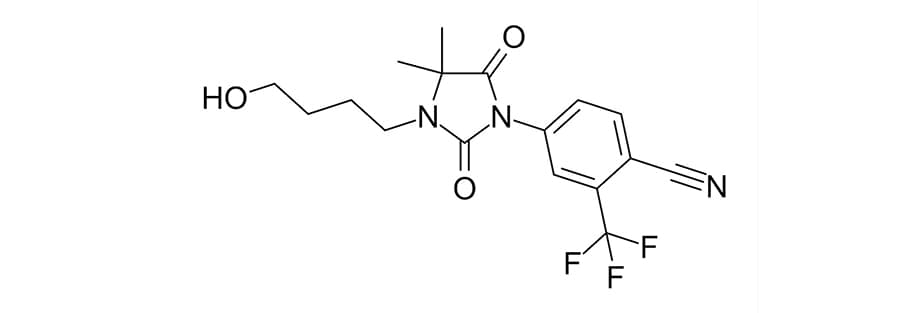
When taking certain types of hair loss medication, the user may experience a degree of shedding. In most cases, this is completely normal and is in no way an unusual situation. This article will discuss RU58841 and whether users need to worry about shedding or not.
Yes, RU58841 does cause shedding. But any hair loss medication that affects the hair growth cycle will cause temporary shedding. Shedding is part of the treatment and is a normal reaction. However, shedding should cease the longer you use the product.
Even though shedding and hair loss might look like the same thing, they are not. There is a difference between shedding hairs due to treatment and hair loss itself. In most cases, shedding is not something to worry about.
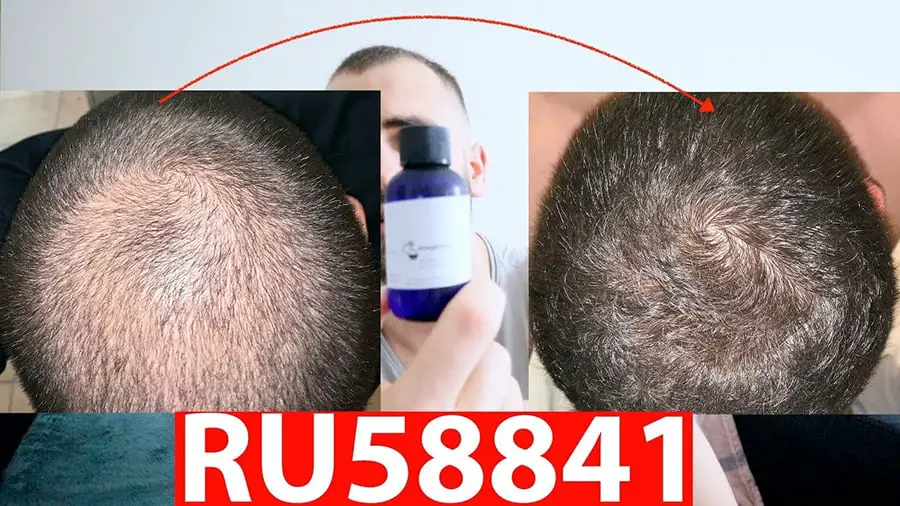
Shedding vs. Hair Loss
Understanding the difference between shedding and hair loss can ease some of the anxiety with shedding. Shedding is mostly normal during the first stages of treatment. But it can still feel alarming when you feel like the medication is not working. And it is making your hair even worse.
Shedding occurs for various reasons. The person could be under a lot of stress, which is causing extreme hair shedding. Or, the person could be taking medication that inadvertently causes hair shedding.
Hair loss is a different matter. Hair loss stops the hair from growing. There are also various reasons for this phenomenon. For example, male pattern baldness is a situation wherein hair stops growing due to miniaturized hair follicles. When hair sheds during the beginning of treatment, this does not automatically mean that the hair shed is lost.
A good test to see whether you have shedding or hair loss is to try plucking hairs from the side of your head, where the follicles are unaffected by DHT. Shedding will cause you to lose hair all over, whereas true hair loss occurs by the hairline and the crown. If you’re plucking hairs from all over your entire head, it’s just temporary hair shedding.

The Hair Growth Cycle
The hair growth cycle is crucial in understanding why most treatments, RU58841 included, shed hair. Let’s talk about each part of the hair growth cycle.
Anagen
Anagen is where the hair actively grows. Eventually, new hair will form and start pushing out the old hair, which is no longer in the anagen phase of growth. The interesting aspect of anagen is that it has a limit. People cannot grow their hair as long as Rapunzel’s. Hair has an active phase of growth that reaches an average of 6 years (Burg et al., 2017). But hair can easily extend up to 7 years. Basically, hair growth is not unlimited.
Without a limited active phase of growth, your leg hair would not stop growing. That would both be difficult to maintain and unappealing. The length of the active phase differs among people. Some might have trouble with growing their hair long because of their shorter active growth phase.
Catagen
We can best describe catagen as a transitional period. It lasts about an average of two weeks. In this period, the hair stops growing and gets ready to enter a time of rest. This part is the shortest phase among all the three phases of hair growth.
Telogen
The last part of the hair growth cycle is naturally when the hair starts to fall off. Telogen lasts about 100 days or three months in most people. This part is when the hair is completely at rest, and new hair is ready to form. Telogen hairs fall at a rate of up to 100 hairs on a healthy person. It can go below that to around 25 hairs at the least. However, these are not hard rules, and it still differs among people.
The three parts of the hair growth cycle do not occur at the same time. Otherwise, you would have a completely bald head at any given time. Some 90% of your hairs are in anagen at any random time, 1% in catagen, and the rest are in telogen (Whiting, 1998).
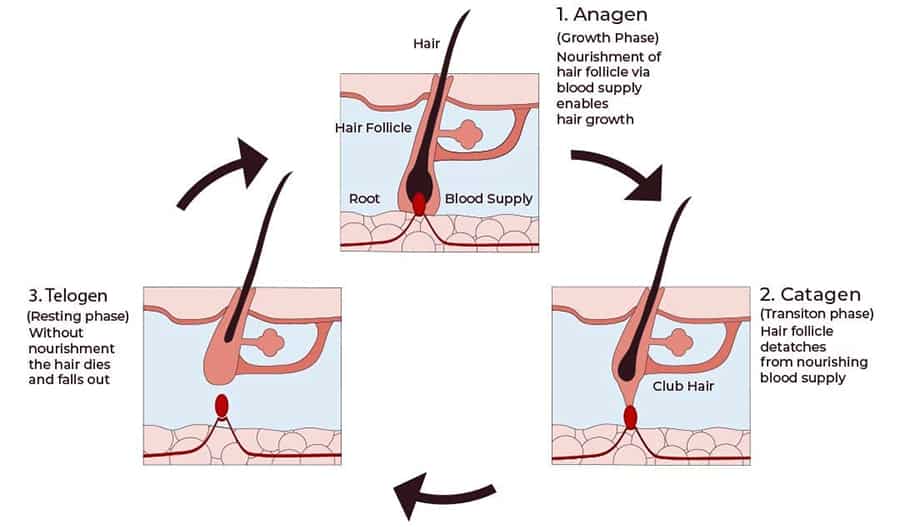
So what does all that have to do with shedding and hair loss?
Disruption of these stages causes the phases to go out of balance. This imbalance can be because of anything from hormones to lack of proper nutrition.
In male-pattern baldness, in particular, this disruption occurs as well. The culprit for this is an androgen called DHT. DHT either reduces the active period or lengthens the resting phase. This disruption occurs over a long period, effectively shrinking the hair follicle. Eventually, the hair will not be able to grow at all. We call this process miniaturization.
So, what does RU58841 have to do with all of these?
Ru58841 and Shedding
Like any other hair loss treatment that attacks DHT, RU58841 will cause hormonal changes. Or, at least, the medication will change the effects of those hormones.
5-alpha is the enzyme that transforms testosterone into DHT. RU58841 does not attack 5-alpha reductase. Instead, RU58841 directly counteracts androgens’ effects – not just DHT, but all androgens, including testosterone. In effect, hair growth will be supercharged.
But in the beginning, there will be a massive overhaul in the hair follicles. All the hairs that were previously in telogen (resting phase) will be activated. This activation will spur the old hair to move out of the way and for new hair to come in. As you can see, it isn’t really about losing hair. The shedding is about taking out the old and coming in with the new.
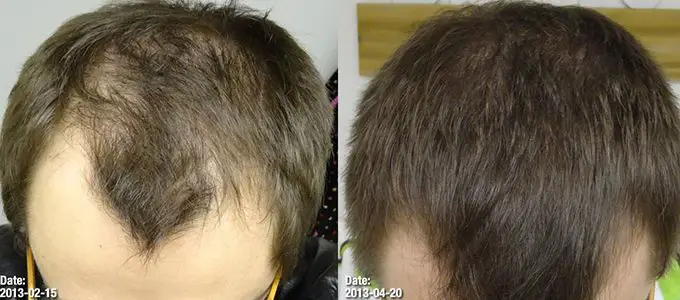
The shedding will not occur automatically. It may take a few weeks for the shedding to occur, and it will not happen simultaneously.
So, if you have concerns with RU58841 and shedding, yes, it will occur. But it is nothing to worry about and is just a sign that the product is working. Furthermore, it happens all over your head, and it’s not like it’s concentrated in one spot. It won’t make a noticeable impact on your hairline.
Other DHT Blockers
There are only two FDA approved medications for pattern hair loss for androgenic alopecia. Unfortunately, RU58841 is not one of those. Given that it has very little research to its name, this is not surprising. Though RU58841 has been around for some time, there is still little to not much research dedicated to it. Most of the information that is available on its human use relies on personal anecdotes. This level of information may not be enough for you. In case of that, there are other DHT blockers:
Finasteride/Propecia
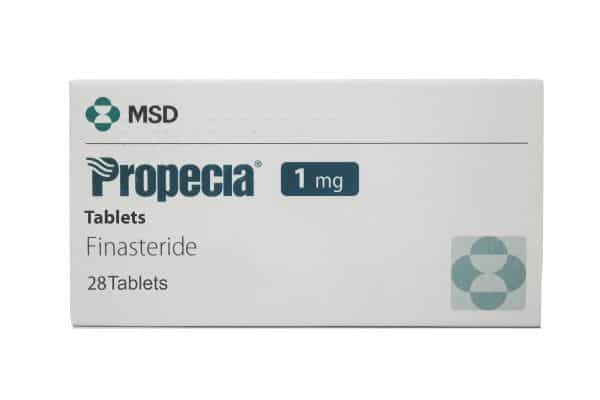
Finasteride is one of the only two FDA approved male pattern hair loss medications, the other being minoxidil. Finasteride has years of research to back its effectiveness and safety profile. Propecia is the brand name of finasteride. However, there are still possible side effects that can occur.
The medication works by attacking 5-alpha reductase. It does this so that the body will not produce too much DHT. Thus, it will not cause hair follicle miniaturization. The problem with that is it may also mess with the body on a larger systemic level. RU58841 is localized on the scalp only, but finasteride is not. Finasteride does not choose where DHT gets reduced, so it may cause significant issues such as:
- decreased libido
- dizziness
- unusual weight changes
- headaches
- back pain
- stomach pain
- drowsiness
- rash
These all have varying degrees of rarity. But they have all manifested in users of finasteride. Additionally, this is not a complete list of side-effects. Others are far less common than the ones listed above. Some users report side-effects (especially erectile dysfunction) lasting months after they have ceased use of the drug, in a phenomenon called post-finasteride syndrome.

Still, the side-effects are not a complete deterrent to using finasteride. They are not guaranteed to happen. Most people can use the medication with bearable sides. It is all up to you on what you think you can tolerate. Plus, cutting the dosage in half is always a reasonable option if you get sides.
Lycopene
A natural option for a DHT blocker is lycopene. Some studies show that lycopene may also reduce DHT levels in the body (Liu, 2008). It may also be able to assist with prostate problems. Plus, lycopene is easy to access. You will have no problem with getting your hands on it.
Saw Palmetto
Another effective and natural remedy for hair loss is saw palmetto. The supplement is an extract from a tree and has been available forever. Indigenous people have been using it as a remedy for many ailments. Today, saw palmetto extract is available as a supplement. It can help with hair loss, prostate issues, and urinary problems as well.
If you’re worried about your hairline, be sure to check out our main hair loss guide and natural hair loss treatment guide.


